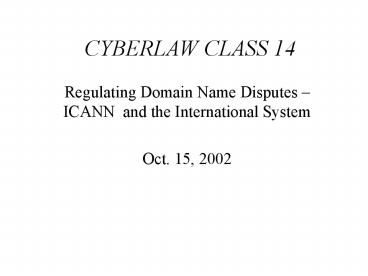CYBERLAW CLASS 14 - PowerPoint PPT Presentation
1 / 8
Title:
CYBERLAW CLASS 14
Description:
Domain names have also become significant as business identifiers. Thus, domain names clash with the existing trademark system and have given rise ... – PowerPoint PPT presentation
Number of Views:270
Avg rating:3.0/5.0
Title: CYBERLAW CLASS 14
1
CYBERLAW CLASS 14
- Regulating Domain Name Disputes ICANN and the
International System - Oct. 15, 2002
2
Domain Names
- What is a domain name? What is an example of a
domain name? - How important are domain names to international
trade?
3
Domain Names
- Domain names, such as http//www.law.cua.edu
- are human-friendly forms of Internet
addresses. They are designed to serve the
function of enabling human users to identify and
recognize computers in an easy manner without
having to remember the numeric IP addresses
computers use (such as 192.91.247.53) - Domain names have also become significant as
business identifiers. Thus, domain names clash
with the existing trademark system and have given
rise to significant IPR challenges and policy
issues because domain name system is essentially
global, whereas IPRs are exerciseable only in a
particular territory. - Domain Name System- are there enough TLDs?
4
ICANN
- ICANN is an acronym for the Internet Corporation
for Assigned Names and Numbers. - A private non-profit corporation based in Marina
del Rey, California, ICANN has the task of
managing the domain name system. - ICANNs legitimacy to do this has been
questioned, and the organization has been
frequently attacked for being undemocratic as
well as providing inadequate representation for
much of the world. - In Sept. 2002, US Commerce Dept extended its
agreement with ICANN until Sept. 2003. Was this
wrong?
5
Cybersquatting
- What is cybersquatting?
6
Genesis of ICANNs Dispute Resolution Policy
- U.S. Government 1998 White Paper that resulted in
the formation of ICANN also provided that the
U.S. Government would ask WIPO to develop
recommendations for an international
cybersquatting dispute resolution policy. WIPO
was to use a procedure that would take into
account the views of international trademark
holders and Internet users. - In 1999, WIPO advised that ICANN should establish
a dispute-resolution policy providing for a
global, inexpensive, and quick arbitration
procedure for domain name disputes. - ICANN set up such a dispute resolution policy.
7
Uniform Dispute Resolution Policy
- If a TM holder believes that a domain name
registration infringes on its trademark rights,
it can institute a proceeding under the UDRP - Under the standard dispute resolution terms of
Terms and Conditions of registration agrement of
accredited registrars, domain name registrants
must submit to such proceeding.
8
UDRP Proceeding
- Complaint must specify domain name, holder of
name, registrar where registered and grounds for
complaint. - Result domain name is transferred or complaint
denied and respondent keeps domain name.
Alternatively, complainant can seek cancellation
of domain name registration. - No monetary damages or injunctive relief will be
awarded under UDRP - Registrar must implement after 10 days unless
appealed to court (rare)































